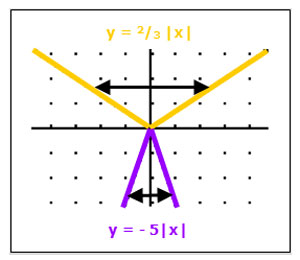What happens if we change "a" in y = a | x - h | + k ?
The parameter “a” has two possible effects on the graph:
- If “a” is positive (a > 0), the absolute value graph opens up.
If “a” is negative (a < 0), the absolute value graph reflects across the x-axis and opens down.
- If | a | > 1, then the absolute value graph is narrower than the graph of the parent function.
(The graph has been stretched.)
If 0 < | a | < 1, then the absolute value graph is wider than the graph of the parent function.
(The graph has been compressed.
- We use the absolute value of “a” because the sign of “a” does NOT affect the openness of the absolute value graph.
- The sign of “a” ONLY determines whether the absolute value graph opens up or down.
Example: Determine which of the functions is the widest: y = -3 | x | or y = two-thirds
2
3
| x |
The coefficient of | x | “a”, determines:
- whether the absolute value graph opens up or down and
- the openness of the absolute value graph
For y = two-thirds
2
3
| x | ⇒ a = two-thirds
2
3
For y = -5 | x | ⇒ a = -5
- Remember that the sign of “a” ONLY determines whether the absolute value graph opens up or down. The openness of the absolute value graph is determined by | a |.
| two-thirds
2
3
| = two-thirds
2
3
and | -5 | = 5
Since two-thirds
2
3
< 5, then y = two-thirds
2
3
| x | is wider than y = -5 | x |.

Close this window or tab to return to the lesson.

